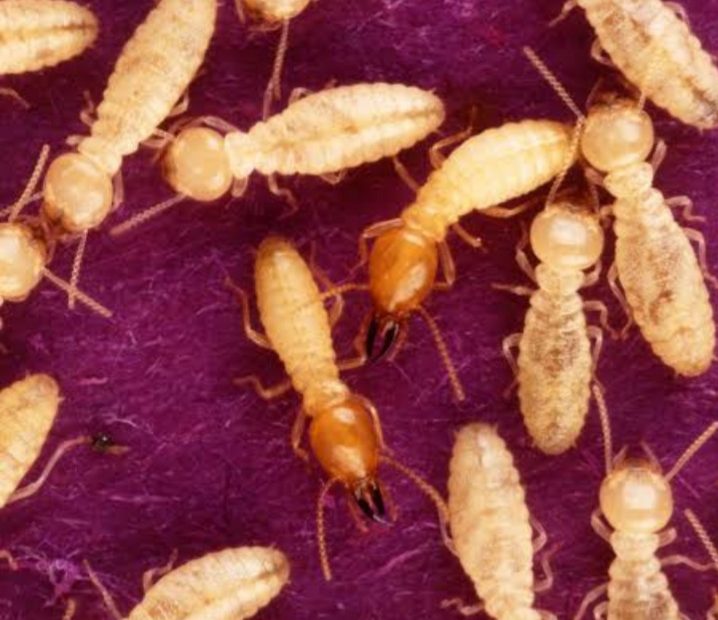

Termite is a social insect that belongs to the family of Termitoidae and infraorder of Isoptera.
This family is made up of 4 subfamilies namely; Apictotermitinae, Macrotermitinae, Termitinae and Nasutitermitinae.
Even though termite is sometimes referred to as a white ant, yet it is not in any way an ant. Termite is categorised into fertile male (king), fertile female (queen), sterile male (worker) and sterile female (soldiers).
This insect normally raises its young as a group. It is a detritivore since it normally feeds on cellulose and dead organic materials such as plant detritus, seeds, grasses, faeces, litters, leaves, soil, dead bodies, dead animals and waste products etc.
Termite sheds its wings when it spots a conducive place to build its nest. Being referred to as a silent destroyer, this insect can silently eat up trees, buildings, papers, woods and properties unnoticed.
Termites measure approximately 4 to 15 millimetres in length. They usually bear a tiny labrum and a clypeus, which is divided into an anteclypeus and postclypeus.
Most soldier and worker termites are blind as they lack eyes however, some species, like Hodotermes mossambicus are distinguished by their compound eyes.
Termite’s antennae has a sense of feel, taste, vibration, touch, heat and odours (pheromones). The worker termites carry out the major task such as providing food, storing food, foraging, building and maintaining the nest.
Termite queen is considered the only insect with the longest lifespan on earth at up to fifty years of age. Just like the grasshopper, termite undergoes incomplete metamorphosis from egg, nymph to adult. The queen termite produces the egg for the colony whereby the abdomen expands to boost fertility.
During a certain time of the year and at the onset of nuptial flight, the queen produces reproductive winged alates and large swarms of termites from the colony.
The flying termites and termite alates migrate from the colony during the nuptial flight in search of a convenient place. Termites mounds are normally constructed out of a mixture of termite saliva, termite dung and soil. Even though the mounds look solid, yet the structures are very porous with tiny interstices through which air and liquid can pass through.
Termites are rich in vitamin A, vitamin C, fat while anti-nutrient components were low.
Studies showed that termite is a good source of protein and other micro and macronutrients and as such its consumption should be promoted.
Certain termite species, for example, the flying termites, flying Alates or Macrotermes bellicosus, queen termites, reproductive soldier termites etc are edible and remain a major source of food especially in the developing and underdeveloped parts of the world.
Flying alates are known by different names by different people for example, the Igbo people refer to it as aku mkpu, Akwa-ibom people refer to it as ebu, Yorubas call it esusun while the Hausa people call it khiyea.
The flying termites are usually collected while flying or after their wings have fallen off. During collection, these termites are added in bucket or bowl of water after which they are properly cleaned.
Afterwards, the ants are either fried in their fat or in oil before consumption.
Fried termites are also used for preparing uma leaves moi moi, plantain moi moi (ukpo ogede), beans etc dishes. Termites can also be steamed, roasted or boiled before consumption.
The use of termites for medicinal purposes is common especially in the rural parts of the world including Australian Aboriginal.
According to some scienitists, approximately 45 species of termites from four families are used all over the world, with 43 species being part of human diet and livestock feeds. Nine termite species were recorded to be used for therapeutic purposes. Africa is the continent with the highest number of usage, followed by America and Asia respectively. The results show that termites are useful for medicinal and food purposes to humanity.
It has been discovered that Microcerotermes exiguus contains antiviral properties and as such effective for treating cold, cough, hoarseness, asthma, catarrh, bronchitis, influenza, flu, whooping cough, sore throat, sinusitis and tonsillitis.
Furthermore, Padilla et al., (2015) evaluated some extracts from termite-associated bacteria in vitro antiviral activity against bovine viral diarrhea virus (BVDV).
They identified 2 bacterial strains as active, with 98% of inhibition (IP). They also identified that a 100% methanol fraction contain the compound(s) responsible for antiviral activity with SI of 262.41. The study present new information for antiviral research of Streptomyces chartreusis compounds isolated from termite mounds against BVDV and for the treatment of HCV infection.
Studies reveal that termites produce up to 11% of atmospheric methane, which is among the prime greenhouse gases, formed during the breakdown of cellulose. Termites break down complex molecules that plants could not use by feeding, decomposing and defecating into the soil. This equally helps to recycle and increase the soil nutrient contents. Termites also help to aerate the soil while building their mounds that contain a high amount of phosphorous and nitrogen to support plant growth.
Furthermore, Termite mounds are used in preparing herbal medicines for treating gastrointestinal diseases due to the kaolin clay substance found in it. It can be used for treating cholera, dysentery, swelling of large intestine, indigestion, stomach ache and diarrhoea
Solavan et al., (2006) study showed that Odontotermes formosanus can be used for treating ulcer.
Termite mounds are used for preparing herbal concoctions applied on the stomach of pregnant women. Studies reveal that the mounds contain a high amount of calcium and iron that are helpful for pregnant women.
Culled / Titilayo Kupoliyi